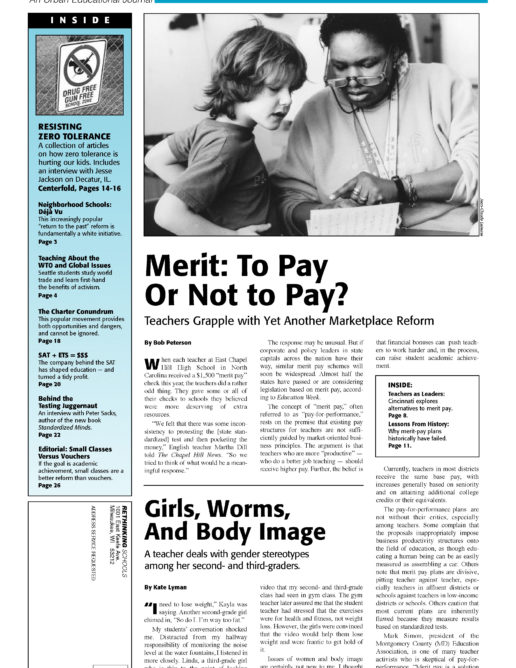Resisting Zero Tolerance
Not long ago, the principal in our children’s high school announced a new policy – zero tolerance. From now on, she said, there would be no excuse for violating certain school rules, notably the ban on student use of drugs and alcohol. At first, the announcement seemed harmless, if a little odd – after all, there had never been any murkiness or ambiguity about the standard of behavior: Kids shouldn’t drink or do drugs. What could a zero-tolerance policy possibly add? Further, drug and alcohol abuse suddenly had a new and privileged position in the hierarchy of misbehavior- fighting wasn’t on the list yet, nor were racial bigotry, disrespect, sexual assault, and a whole lot more.
Shortly after the new policy was implemented, we asked the principal about it. She explained that zero tolerance was simply an attempt to re-focus on existing rules, something to get the kids’ attention. “We want to clarify what we already do,” she explained.
Zero tolerance policies have by now become commonplace in our schools. What began, perhaps, as clarification has morphed rapidly into Frankenstein’s monster, destroying children in its path.
Some 90 children are now suspended or expelled from the Chicago Public Schools each week. The vast majority are excluded from their schools for non-violent misdeeds. Schools everywhere – public, private, urban, suburban, rural, and parochial – are turning into fortresses where electronic searches, locked doors, armed police, surveillance cameras, patrolled cafeterias, and weighty rule books define the landscape.
Ironically, elaborate security hardware fails to create school safety. Recent research indicates that as schools become more militarized they become less safe, in large part because the first casualty is the central, critical relationship between teacher and student, a relationship that is now being damaged or broken in favor of tough-sounding, impersonal, uniform procedures.
Children are different from adults, and are likely to recover from misbehavior and mistakes when given proper guidance, challenge, and support. And each child is, of course, an individual, with particular strengths and needs. No child is entirely understandable through his or her worst actions. So adults cannot give up on kids, even those who get into trouble again and again, even those who have been involved in a serious offense.
The seven young men in Decatur, for example, who came together in an unsavory and typical teenage brawl that frightened more than it harmed, are clearly distinct people with dramatically different records, needs, hopes, and challenges. A fair approach, a common-sense approach to their misbehavior would be to fashion a punishment that would teach but not cripple, educate and develop but not destroy.
But in Decatur, we see another all-too-common underbelly of zero tolerance – the racialized use of the concept in practice. After all, when everyone keeps insisting, “This isn’t about race,” race is the thing it is most assuredly about.
We need teachers, educators, parents, and school boards to reclaim schools as sites of learning and growth – places where incidents of misbehavior, poor choices, wrongdoing and, yes, even crimes, are generally handled within the school setting based on principles of repairing the harm, recognizing the consequences, and developing talents and assets. There are numerous models of school sanctioning which work for all but a few behaviors: old-fashioned remedies like detention halls, time out, letters of apology, contacting parents, losing school privileges; and more modern restorative justice approaches such as peer juries, community service, community panels, teen courts, intensive supervision. Obviously, any such system can become either mechanical or abusive, but these remedies could be part of a context of learning which engages youth themselves in a question of vital interest to them: What’s fair?
Now is the time for parents, teachers, citizens, and youth themselves to come together sensibly to resist zero tolerance. We begin by remembering that a child is a child, and that teenagers are negotiating a particular stage of human development. Most important, we must remember that adolescence is by definition a time of immaturity, of experimentation, of predictable mistakes. No human being, after all, is experienced before being inexperienced, wise before naive, polished before clumsy.
Adolescents need steady grown-ups to talk to, to think with, to bounce ideas off. Closing the door is a form of abandonment, of neglect. Closing the schoolhouse door can become, as well, an economic death sentence or a straight line to detention for school attendance is a critical protective factor in keeping kids out of juvenile and criminal justice systems and away from a life on the streets.
Zero means none or nothing. Tolerance gestures toward understanding, generosity, kindness, benevolence, justice, forgiveness. Our children need maximum understanding, sensible standards, benevolence, justice, and then a chance to grow beyond their transgressions. We need to teach tolerance, and practice it too.
William Ayers is Distinguished Professor of Education and Senior University Scholar at the University of Illinois at Chicago. His most recent book is A Kind and Just Parent. Bernardine Dohrn is Director of the Children and Family Justice Center at Northwestern University School of Law, Legal Clinic. She is the author of Look Out Kid, It’s Something You Did: Zero Tolerance for Children in the forthcoming Violence and Children’s Rights, edited by Valerie Polakow. Together they have three sons.
![]()
![]()

